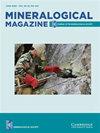Thermodynamics and crystal structures of krautite, Mn[AsO3(OH)]⋅H2O, koritnigite, Zn[AsO3(OH)]⋅H2O and cobaltkoritnigite, Co[AsO3(OH)]⋅H2O
IF 2.8
3区 地球科学
Q2 MINERALOGY
引用次数: 0
Abstract
Abstract Synthetic samples of krautite, Mn[AsO3(OH)]⋅H2O, koritnigite, Zn[AsO3(OH)]⋅H2O and cobaltkoritnigite, Co[AsO3(OH)]⋅H2O, were used for calorimetric experiments. For krautite and koritnigite, single-crystal X-ray diffraction was used to determine positions of all atoms, including the H atoms. These data allowed the hydrogen-bond network and the function of H2O molecules in these structures to be determined. The structural formulae are Mn4(H2[3]O)4[AsO3(OH)]4 and Zn4(H2[3]O)2[AsO3(OH)]4(H2[4]O)2, where [3]H2O and [4]H2O are the ‘transformer’ and ‘non-transformer’ H2O groups, respectively. Even though the principal features of these structures are identical, the details, especially those regarding the H2O groups, differ from one structure to another structure in this group. The solubility products (log Ksp) were determined from calorimetric data, that is, from the experimentally measured enthalpies of formation and entropies. They relate to the reaction M[AsO3(OH)]⋅H2O → M2+ + HAsO42– + H2O and are –6.10 for krautite, –6.88 for koritnigite and –6.83 for cobaltkoritnigite. We also estimated the log Ksp for magnesiokoritnigite as –2.0. Calculation of phase diagrams shows that all these phases originate under acidic conditions from solutions with high metal and arsenate concentration. They are restricted to local environments, to pockets that maintain such high concentrations over the time necessary for crystallisation of the krautite-group phases.镁云母Mn[AsO3(OH)]⋅H2O、钾褐铁矿、Zn[AsO3(OH)]⋅H2O和钴褐铁矿、Co[AsO3(OH)]⋅H2O的热力学和晶体结构
摘要:采用水铁矿、Mn[AsO3(OH)]∙H2O、钾镍矿、Zn[AsO3。对于钾铁矿和钾铁矿,使用单晶X射线衍射来确定包括H原子在内的所有原子的位置。这些数据使得氢键网络和H2O分子在这些结构中的功能得以确定。结构式为Mn4(H2[3]O)4[AsO3(OH)]4和Zn4(H2[3]O)2[AsO3。尽管这些结构的主要特征是相同的,但在该组中,细节,特别是关于H2O基团的细节,因结构不同而不同。溶解度产物(log Ksp)由量热数据确定,即由实验测量的形成焓和熵确定。它们与反应M[AsO3(OH)]-H2O有关→ M2++HAsO42–+H2O,对于钾铁矿为–6.10,对于钾镍矿为–6.88,对于钴钾镍矿则为–6.83。我们还估算了镁质辉长岩的log Ksp为–2.0。相图的计算表明,所有这些相都是在酸性条件下由高金属和砷酸盐浓度的溶液产生的。它们被限制在局部环境中,被限制在在克拉特群相结晶所需的时间内保持如此高浓度的区域中。
本文章由计算机程序翻译,如有差异,请以英文原文为准。
求助全文
约1分钟内获得全文
求助全文
来源期刊

Mineralogical Magazine
地学-矿物学
CiteScore
4.00
自引率
25.90%
发文量
104
审稿时长
6-12 weeks
期刊介绍:
Mineralogical Magazine is an international journal of mineral sciences which covers the fields of mineralogy, crystallography, geochemistry, petrology, environmental geology and economic geology. The journal has been published continuously since the founding of the Mineralogical Society of Great Britain and Ireland in 1876 and is a leading journal in its field.
 求助内容:
求助内容: 应助结果提醒方式:
应助结果提醒方式:


